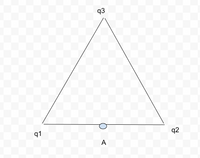
College Physics
11th Edition
ISBN: 9781305952300
Author: Raymond A. Serway, Chris Vuille
Publisher: Cengage Learning
expand_more
expand_more
format_list_bulleted
Concept explainers
Question
Three point-like charges are placed at the corners of an equilateral triangle as shown in the figure. Each side of the triangle has a length of 24.0 cm, and the point (A) is located halfway between q1 and q2 along the side. Find the magnitude of the electric field at point (A). Let q1 = −2.90 μC, q2 = −3.00 μC, and q3= −4.90 μC.

Transcribed Image Text:93
q1
q2
A
Expert Solution
This question has been solved!
Explore an expertly crafted, step-by-step solution for a thorough understanding of key concepts.
This is a popular solution
Trending nowThis is a popular solution!
Step by stepSolved in 2 steps with 2 images

Knowledge Booster
Learn more about
Need a deep-dive on the concept behind this application? Look no further. Learn more about this topic, physics and related others by exploring similar questions and additional content below.Similar questions
- Four point charges have the same magnitude of 3.2 × 10-¹² C and are fixed to the corners of a square that is 6.2 cm on a side. Three of the charges are positive and one is negative. Determine the magnitude of the net electric field that exists at the center of the square.arrow_forwardReview Conceptual Example 11 before attempting to work this problem. Four charges with equal magnitudes of 9.24 x 10-12 Care placed at the corners of a rectangle. The lengths of the sides of the rectangles are 3.23 cm and 6.21 cm. Find the magnitude of the electric field at the center of the rectangle in Figures a and b. (a) Number (b) Number i i 2, E13 E24 E24 44 3 +9 +9 +9 4 +4 Units Units (b) +9arrow_forwardthe diagram as shown. The charges of each marble are q₁6.50 μC, 9₂ 1.17 pc, and q3 -1.79 μC. Marble q, is a distance r = 3.00 cm to the left of the marble q₂, while marble q, is a distance r3 - 2.00 cm to the right of the marble q2, as shown. Calculate the magnitude of the electric field a distance = 1.00 cm to the left of the center marble. N/C 4 observation point 92 r₂ = 0m Another marble is placed 1 cm to the left of the middleimarble. If this new marble has a charge of 3.71 µC, calculate magnitude and direction of the force on it. 77. x magnitudearrow_forward
- Three charges are placed along the x-axis: q1 = 3.00 µC at X1 = -20.0 cm, q2 = -5.00 µC at x2 = 10.0 cm, and q3 = 6.00 µC at x3 = 25.00 cm. Determine the magnitude of the electric field at the origin. O 4 69x106 N/C O 2 96x106 N/C O 6 04x106 N/C O 4.31x106 N/Carrow_forwardThree identical charges (q = -7.0 μC) lie along a circle of radius 3.9 m at angles of 30°, 150°, and 270°, as shown in the figure below. What is the resultant electric field at the center of the circle? 9 N/C 270° 150° 30°arrow_forwardThree point-like charges are placed as shown in the figure, a = 20.0 cm and b = 66.0 cm. The charge (q) is placed halfway on the (b) side. Find the magnitude of the electric field at the top left corner. Let q1 = −2.00 μC, q2= −3.90 μC,and q3= −3.70 μCarrow_forward
- The point charges in the figure below are located at the corners of an equilateral triangle 20.0 cm on a side. (Assume that the +x-axis is to the right and the +y-axis is up along the page.) (a) Find the electric field (in N/C) at the location of qa in the figure, given that qb = +19.00 µC and qc = −8.00 µC. magnitude _______ N/C direction __________° counterclockwise from the +x-axis (b) What is the force (in N) on qa, given that qa = +2.50 nC? magnitude ______N direction _________° counterclockwise from the +x-axisarrow_forwardIn the figure, the four particles are fixed in place and have charges q, = q2= 5e, q3 = 3e, and q4 = -12e (e = 1.6 × 10-19 C). Distance d= 5.0 µum. What is the magnitude of the net electric field at point P due to the particles? 4 Give your answer in N/C. (ke = /4ne, = 9.0 × 10° Nm²/C²)arrow_forward
arrow_back_ios
arrow_forward_ios
Recommended textbooks for you
 College PhysicsPhysicsISBN:9781305952300Author:Raymond A. Serway, Chris VuillePublisher:Cengage Learning
College PhysicsPhysicsISBN:9781305952300Author:Raymond A. Serway, Chris VuillePublisher:Cengage Learning University Physics (14th Edition)PhysicsISBN:9780133969290Author:Hugh D. Young, Roger A. FreedmanPublisher:PEARSON
University Physics (14th Edition)PhysicsISBN:9780133969290Author:Hugh D. Young, Roger A. FreedmanPublisher:PEARSON Introduction To Quantum MechanicsPhysicsISBN:9781107189638Author:Griffiths, David J., Schroeter, Darrell F.Publisher:Cambridge University Press
Introduction To Quantum MechanicsPhysicsISBN:9781107189638Author:Griffiths, David J., Schroeter, Darrell F.Publisher:Cambridge University Press Physics for Scientists and EngineersPhysicsISBN:9781337553278Author:Raymond A. Serway, John W. JewettPublisher:Cengage Learning
Physics for Scientists and EngineersPhysicsISBN:9781337553278Author:Raymond A. Serway, John W. JewettPublisher:Cengage Learning Lecture- Tutorials for Introductory AstronomyPhysicsISBN:9780321820464Author:Edward E. Prather, Tim P. Slater, Jeff P. Adams, Gina BrissendenPublisher:Addison-Wesley
Lecture- Tutorials for Introductory AstronomyPhysicsISBN:9780321820464Author:Edward E. Prather, Tim P. Slater, Jeff P. Adams, Gina BrissendenPublisher:Addison-Wesley College Physics: A Strategic Approach (4th Editio...PhysicsISBN:9780134609034Author:Randall D. Knight (Professor Emeritus), Brian Jones, Stuart FieldPublisher:PEARSON
College Physics: A Strategic Approach (4th Editio...PhysicsISBN:9780134609034Author:Randall D. Knight (Professor Emeritus), Brian Jones, Stuart FieldPublisher:PEARSON

College Physics
Physics
ISBN:9781305952300
Author:Raymond A. Serway, Chris Vuille
Publisher:Cengage Learning

University Physics (14th Edition)
Physics
ISBN:9780133969290
Author:Hugh D. Young, Roger A. Freedman
Publisher:PEARSON

Introduction To Quantum Mechanics
Physics
ISBN:9781107189638
Author:Griffiths, David J., Schroeter, Darrell F.
Publisher:Cambridge University Press

Physics for Scientists and Engineers
Physics
ISBN:9781337553278
Author:Raymond A. Serway, John W. Jewett
Publisher:Cengage Learning

Lecture- Tutorials for Introductory Astronomy
Physics
ISBN:9780321820464
Author:Edward E. Prather, Tim P. Slater, Jeff P. Adams, Gina Brissenden
Publisher:Addison-Wesley

College Physics: A Strategic Approach (4th Editio...
Physics
ISBN:9780134609034
Author:Randall D. Knight (Professor Emeritus), Brian Jones, Stuart Field
Publisher:PEARSON